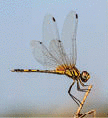
![]()

We often overlook how complicated it is to keep balance in nature. We see a video of an animal killing another animal and recoil in distaste at the violence and the death of what appears to be an innocent animal. We fail to realize how important it is for predators to exist. Without predators the plant-eating animals would quickly eat all of the plants and not only would they starve to death, but all life would eventually cease to exist. Maintaining balance between the food supply and the animals that depend upon that food supply is very complicated.
Nowhere is this more true than in the insect world. If we did not have animals that feed on insects the “bugs” in the creation would create ecological havoc. One of the best-designed bug-eaters is the dragonfly. Dragonflies eat incredible numbers of flies, and researchers have found that the design of the dragonfly allows this to happen. There is a circuit of 16 neurons that connect a dragonfly’s brain to its flight motor center in the thorax. This allows the dragonfly to track a moving target and intercept it. Robert Olberg in a recent issue of the Proceedings of the National Academy of Science has shown how the dragonfly uses vector mechanics in such a way that the image of the prey is always on the same spot in the retina of its eye allowing 100% sure contact with the target.
Also, dragonflies can hover, dive, fly backward, and upside down, and pivot 360 degrees. They reach speeds of 30 miles per hour and their eyes are giant spheres with 30,000 pixel-like facets that allow them to see every direction at once. With all of this hardware, the dragonfly brain is very simple having less than a million neurons. (Human brains have 100 billion neurons.) The dragonfly is a well-designed insect-eater that keeps a balance in nature among insects. Lions catch 25 % of their prey and great white sharks about 50%, but the kill ratio for dragonflies is essentially 100%. Proverbs 8 proclaims God’s wisdom and calls us to understand the wisdom we see in every corner of the creation: “Does not wisdom call out? Does not understanding raise her voice? … You who are simple, gain prudence; you who are foolish, gain understanding. Listen, for I [wisdom] have worthy things to say” (NIV, 1984). Designing a planet that can last for years is incredibly complicated, and the design of predators like the dragonfly speaks of a God whose intelligence and knowledge of engineering principles is infinite.
Source: National Wildlife, August/September 2014, page 32.
Picture credits:
© forest71. Image from BigStockPhoto.com.
